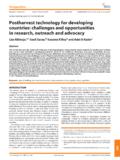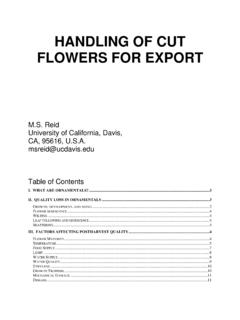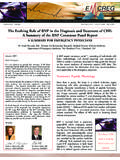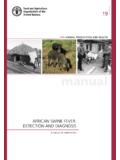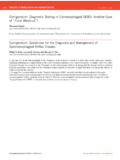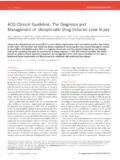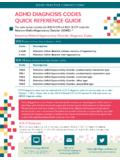Transcription of Problem Diagnosis Avocado 1-20-11 final
1 Problem Diagnosis FOR Avocado Avocado trees are well suited for Southern California. They don't mind alkaline soil too much and they like the climate. They are, in general, tolerant of the heavy pruning that may be needed to keep the tree's growth low enough for convenient homeowner fruit harvesting. Avocado trees are troubled by relatively few pests, the most common of which are various root rot fungi, persea mite, and excess salt accumulations. Fungus is the most serious Avocado disease in California. Fungus thrives in excess soil moisture. Over irrigation and poor drainage and may attack trees of any size or age. Absence of feeder roots prevents moisture uptake so soil under diseased trees stays wet. Diseased trees may set a heavy crop of small fruit but will decline and die, either rapidly or slowly. Fungus can spread by contaminated nursery stock, water in contact with infested soil, shoes, cultivation equipment.
2 Control measures for fungal diseases are to use an integrated approach of prevention, culture, treatment. Plant on soil with good internal drainage; avoid over watering; use clean nursery stock, preferably certified disease free; use resistant rootstocks; prevent soil or water movement from infested areas. In the table below, pink shading represents fungal or bacterial problems, green shading represents insects or other pests, blue shading represents other conditions. What the Problem Looks Like Probable Cause Control Measures Small, pale green, wilted leaves. Avocado root rot Fumigate small spots of disease. If detected early; otherwise, cut off the tree at ground level and Sparse foliage. New leaves fumigate soil. Contact a pest control adviser about soil fumigation. don't grow or are small with Fungicides. Use as part of an integrated control program. poor color. Small branches die Replant infested soil with immune plants, such as any varieties of Citrus, cherimoya, all types of back at top of tree.
3 Vegetables, most annual f1ower crops, and many deciduous fruit trees and berries. Poor growth, loss of tree vigor. Armillaria root rot Also known as oak root fungus. Attacks roots. Visible symptoms may not appear until fungus is well Small, yellowing leaves; established in the roots. Can destroy entire root system and kill tree. Once symptoms appear, it is very premature leaf drop; wilting, difficult to save a tree, and disease may have spread to roots of adjacent trees. After aerial parts of collapse. In winter, clusters of infected trees are dead, the fungus remains alive in the roots to infect any replanted, susceptible trees, fan shaped mushrooms form such as citrus, peach, or Avocado . Fumigate before replanting. Let soil dry out between irrigations at base of infected trees a few days after a rain. Poor growth, loss of tree vigor. Avocado black Causal organism unknown.
4 Attacks trunk and branches. Present in California for more than 60 years but Yellowing) foliage. Poor fruit streak (ABS) observed only on Guatemalan varieties such as Hass and Reed and only after prolonged stress. Since production. Cankers on truck many symptoms are similar to those attributed to other causes, cankers on trunk and branches are and branches. Leaf blotching, diagnostic of ABS. Cankers vary in size and have a dry, powdery, water soluble sugar that exudes wilting. Rapid death of some through tiny cracks in the bark. Shallow red brown lesions under cankers are revealed when bark is new growth. Often death of removed. Management of ABS consists of maintain tree health with good fertilizer and irrigation entire tree eventually. practices. Remove unhealthy trees; it is safest to fumigate the soil if replanting to Avocado . 1 Problem Diagnosis FOR Avocado What the Problem Looks Like Probable Cause Control Measures Leaves suddenly wilt on one or Verticillium wilt May kill all or part of tree, with the remainder having complete recovery.
5 If disease is severe and more parts of tree and then recurring, contact a pest control adviser about soil fumigation. Mexican rootstocks are more resistant turn brown and die but do not than Guatemalan. Do not plant on soil that has been used for other crops susceptible to Verticillium drop off for months. Brown to wilt, such as tomato, eggplant, pepper, many berries, apricot, potato, and several flower crops. Do not gray brown streaks are visible in plant any of these near an Avocado tree. wood of branches or roots. Bark cankers exude white Dothiorella canker Attacks trunk and branches; a minor fungal Problem favored by moisture. Keep irrigation water off tree powder. Outer bark cracks and base. Guatemalan rootstocks or scion tops are much more susceptible than Mexican. Control not usually sheds easily. Diseased trees die needed. Scraping off outer bark removes some infection and encourages regeneration of vigorous bark.
6 Back and may look unhealthy After picking, move fruit to a minimum of 41 F as quickly as possible. Ripen under 60 F to minimize rot. but rarely die. Trunk cankers at base of older Phytophthora canker Collar rot is now widespread in California, second only to Avocado root rot in severity. Disease is favored trees, originating at or below (collar rot) by excess soil moisture, such as from over irrigation or poor drainage. Spreads by contaminated nursery ground level. Canker appears as stock, irrigation water, and cultivation equipment. Use sanitation measures noted for other a dark region with a red, Phytophthora species. Seedling rootstocks are generally more sensitive than clonal stocks, such as Duke resinous exudate that dries to a 7 and Toro Canyon. Since Phytophthora canker is found increasingly together with Avocado root rot, white, crystalline deposit. use an integrated approach to control both.
7 Do not allow the lower trunks of trees to stay wet. Place Underneath the superficial drip emitters away from tree trunks. Avoid wetting tree trunks. Avoid wounding trunks. If cankers are canker is an orange tan to detected at an early stage, they can sometimes be controlled by cutting out the infected tissue. No brown lesion instead of the chemicals are currently registered for use on this disease. normal white or cream colored tissue. Lesion has a fruity odor when exposed. Gradual decline over years or sudden tree death. Fruit hanging near the ground Phytophthora fruit Attacks fruit. Limited to prolonged wet weather in a dry climate like California. Probably caused by has a distinct, rounded black rot disease organisms splashing the soil, so a mulch or leaf layer should help. Removing fruit that touches area, usually at the end toward the ground will remove a likely source of disease.
8 The soil. Rot soon extends internally, sometimes to the seed. 2 Problem Diagnosis FOR Avocado What the Problem Looks Like Probable Cause Control Measures Brown, scattered, dead areas Anthracnose Attacks leaves and fruit. Becomes serious in California only with wet, mild winters. As with Dothiorella on leaves. If extensive, causes fruit rot, important to cool fruits quickly after picking and to ripen them at below room temperature, if severe leaf drop. Infected fruit possible. Removing dead material and pruning to open tree canopy for better aeration are helpful, if develops small, dark spots. needed. Spores germinate and penetrate the fruit before harvest, causing brown to black spots but the Fruit rot develops upon disease does not develop further until after harvest. Resumes growth during ripening. ripening after harvest; the flesh rots are many and smaller than Dothiorella.
9 Lengthwise narrow yellow, sunblotch ( Avocado Attacks all parts of tree. Purchase registered trees for which scion top and rootstock are indexed as red, or necrotic shallow sunblotch viroid) viroid free. Established infected tree can contaminate nearby healthy avocados by wound to wound indentations on twigs. cutting tools. Removal is recommended in such cases. Sterilize pruning tools and harvesting clippers Rectangular fruit with white, between trees. yellow, or reddish streaks. Cracking of bark on trunk and larger branches known as alligator bark'. Tree is stunted. Light green or yellow areas on Avocado brown mite Tiny, brown colored mite about the size of a period, the same size as the persea mite and the Avocado upper leaf surfaces along the mite. Attacks upper leaf surface. Trees injured in proportion to the amount of green leaf area lost. See midrib, later extending to the persea mite for further details.
10 Smaller veins and entire leaf. Areas of severe feeding later turn brown (bronzing of leaves) and leaves may drop. Light green or yellow areas on Avocado mite Tiny, yellow to pale green mite about the size of a period; a pest of avocados primarily in coastal areas. underside of leaves along the Attacks underside of leaves. Formerly known as six spotted mite. See persea mite for further details. midrib and larger veins. Heavy infestations can cause leaf drop. 3 Problem Diagnosis FOR Avocado What the Problem Looks Like Probable Cause Control Measures Small necrotic spots on the persea mite Attacks underside of leaves. A yellowish mite about the size of a printed period. This new mite pest, a underside of leaves along the native to Mexico, was first detected in California in 1990. It spreads rapidly since its webbing protects it midrib and main veins. As and its eggs from the predacious mite Amblyseius hibisci, a common biological control agent in population increases, new California.

